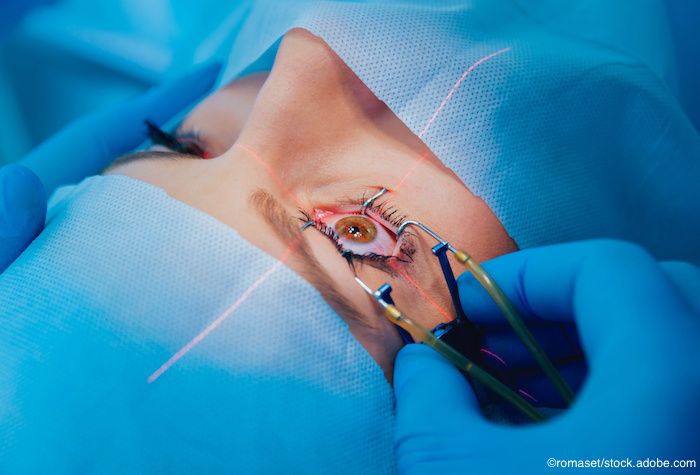Article
5 pearls to manage white cataracts
Author(s):
Better management of white cataracts with these pearls can help avoid complications like the Argentinian flag sign.

Better management of white cataracts with these pearls can help avoid complications like the Argentinian flag sign.
Reviewed by Brock Bakewell, MD, FACS
Salt Lake City-White cataracts require special surgical strategies. One major concern with white cataracts is avoiding the “Argentinian flag sign,” said Brock Bakewell, MD, FACS.
“Some white cataracts have liquid cortex; some do not,” explained Dr. Bakewell, adjunct associate professor, University of Utah, Salt Lake City, and clinical instructor, University of Arizona.
“The ones that have liquid cortex can be a problem,” he said. “You can get a tear-out of the capsulorhexis due to high intralenticular pressure; we know this as the Argentinian flag sign.”
It is also difficult under the slit lamp to tell which white cataracts are under pressure and which are not. Intumescent white cataracts are most at risk for the Argentinian flag sign, he added. Here are Dr. Bakewell’s pearls for managing white cataracts:
1. Apply trypan blue dye under the viscoelastic material
“You can sometimes apply trypan blue (VisionBlue) under air or inject it in the eye directly, but if there happens to be any zonular loss, the posterior capsule may be inadvertently stained,” Dr. Bakewell said. “This will obscure the red reflex and make visualization more difficult as the cataract is disassembled.”
The dye helps with visualization of the capsulotomy since there is no initial red reflex with dense white cataracts, he said.
2. Minimize posterior pressure
Some surgeons like to give a retrobulbar or peribulbar anesthetic injection rather than use topical anesthesia, he said. In those cases, the surgeon should use a Honan balloon or put a mercury bag on the eye to make sure the injected anesthetic diffuses in the orbit.
“If you inject an anesthetic and it doesn’t diffuse, you could end up with posterior pressure that causes a tear-out of the capsulotomy,” he said.
Dr. Bakewell also advises loosening the lid speculum to avoid putting pressure on the lids and giving 250 cc of 20% mannitol intravenously 50 minutes before surgery.
“The mannitol osmotically sucks the vitreous dry and pulls fluid out, so it softens the eye,” he said. This recommendation is based on a previous article from Figueiredo et al.1
3. Use a dispersive viscoelastic
This is another suggestion from Figueiredo et al. After staining, Dr. Figueiredo recommends puncturing of the anterior capsule center with a 30-gauge needle through a side port incision.
“This allows the liquid cortex of an intumescent lens to seep into the anterior chamber and this, in turn, decompresses the anterior compartment of the lens,” Dr. Bakewell said.
However, you also have to depressurize the posterior intralenticular compartment, he added. This can sometimes be accomplished by gently retropulsing the nucleus with the 30-gauge needle.
Failure to decompress the posterior intralenticular compartment of the lens is what can lead to the Argentinian flag sign. The surgeon must then get rid of the cloudy white cortical material to be able to proceed with the capsulotomy.
That can be done by injecting additional viscoelastic material (such as Viscoat/Alcon Laboratories or Healon EndoCoat/Abbott Medical Optics) through the cataract incision into the anterior chamber angle that is opposite of the cataract incision, Dr. Bakewell said.
“That pushes the liquid cortex out of the eye,” he said.
4. Create a 3-mm capsulorhexis
This will help if the posterior cortical space still has increased pressure. The reason to make a 3 mm versus the usual 5 mm is in case the capsulorhexis starts to radialize there’s a greater chance for recovery, Dr. Bakewell said. The capsulorhexis should be made by using coaxial forceps through the side port incision-this keeps the viscoelastic in the eye and makes a capsulotomy tear-out less likely.
Once the capsulotomy is made, Dr. Bakewell advises surgeons to follow Figueiredo’s protocol of bilateral irrigation/aspiration inside the 3-mm capsulorhexis in an effort to decompress the posterior compartment.
“If you don’t decompress the posterior cortical compartment, that’s what causes the posterior pressure that can tear the capsulotomy out when you’re making a 5-mm one,” he said. After that point, the surgeon can enlarge the rhexis to 5 mm and perform phacoemulsification.
5. Consider a femtosecond capsulotomy
The latter was safe and feasible for intumescent white cataracts, according to a report published last year, 2 Dr. Bakewell said.
In the report’s series of 25 eyes, two tears and three incomplete capsulotomies still occurred, he noted.
However, “the bottom line is as the technology gets better and maybe as the nomograms and algorithms get better, maybe we can prevent these tears from occurring,” he said.
Disclosures:
Brock Bakewell, MD, FACS
E: eyemanaz@aol.com
This article was adapted from Dr. Bakewell’s presentation at the 2014 meeting of the American Academy of Ophthalmology. He did not indicate any proprietary interest in the subject matter.
References:
1. Figueiredo CG, Figueiredo J, Figueiredo GB. Brazilian technique for prevention of the Argentinean flag sign in white cataract. J Cataract Refract Surg. 2012;38:1531-1536.
2. Conrad-Hengerer I, Hengerer FH, Joachim SC, Schultz T, Dick HB. Femtosecond laser-assisted cataract surgery in intumescent white cataracts. J Cataract Refract Surg. 2014;40:44-50.
Newsletter
Don’t miss out—get Ophthalmology Times updates on the latest clinical advancements and expert interviews, straight to your inbox.





